Properly fitting clubs are essential for young golfers to ensure optimal performance and technique development. Club length and weight should align with the child’s height and swing mechanics, allowing for adjustments as they grow. This guide helps parents and coaches select the right equipment, fostering a strong foundation for future success in golf.
Junior golf clubs are specifically designed for young golfers, tailored to their size, strength, and swing capabilities. Unlike adult clubs, junior clubs are lighter, shorter, and more flexible, making them easier to handle for children. These clubs are crafted to promote proper technique, reduce fatigue, and enhance performance. They often feature adjustable lengths and loft angles to accommodate growth and skill development. Choosing the right set is crucial, as ill-fitting clubs can hinder progress and lead to frustration. This guide provides insights into selecting the perfect clubs for young golfers, ensuring a smooth transition as they grow and improve their game.
Why Proper Club Size Matters for Young Golfers
Proper club size is crucial for young golfers, as it directly impacts their performance, technique, and overall enjoyment of the game. Clubs that are too long or too short can lead to poor posture, inconsistent swings, and difficulty controlling the ball. Correctly sized clubs ensure a comfortable grip, balanced stance, and efficient swing mechanics, reducing fatigue and the risk of injury. They also help young golfers develop proper form and build confidence, which are essential for skill development. Ill-fitting clubs can hinder progress, while the right size fosters a strong foundation for future success in golf.
Understanding Club Sizing
Club sizing involves matching club length and weight to a golfer’s height and swing mechanics, ensuring optimal performance, comfort, and consistency for young players.
The Impact of Club Length on Performance
Club length significantly affects a junior golfer’s performance, as it influences posture, balance, and swing mechanics. Clubs that are too long can force an inconsistent swing, leading to poor ball-striking and reduced accuracy. Conversely, clubs that are too short may require an unnatural stance, limiting power and control. Properly fitted clubs ensure a natural swing, allowing young golfers to maintain consistency and develop a repeatable technique. The right length promotes better ball flight, distance, and overall performance, making it a critical factor in helping juniors improve their game effectively.
How Club Weight Affects a Junior Golfer’s Swing
Club weight plays a crucial role in a junior golfer’s swing mechanics. Lighter clubs allow for increased swing speed and better control, enabling young players to generate more power with less effort. Conversely, clubs that are too heavy can slow down the swing, leading to fatigue and inconsistent contact. Properly weighted clubs help maintain balance and tempo, promoting a smoother and more efficient motion. This balance is essential for developing a strong, repeatable swing and preventing potential injuries from overexertion. Ensuring clubs are appropriately weighted supports overall performance and long-term skill development in young golfers.
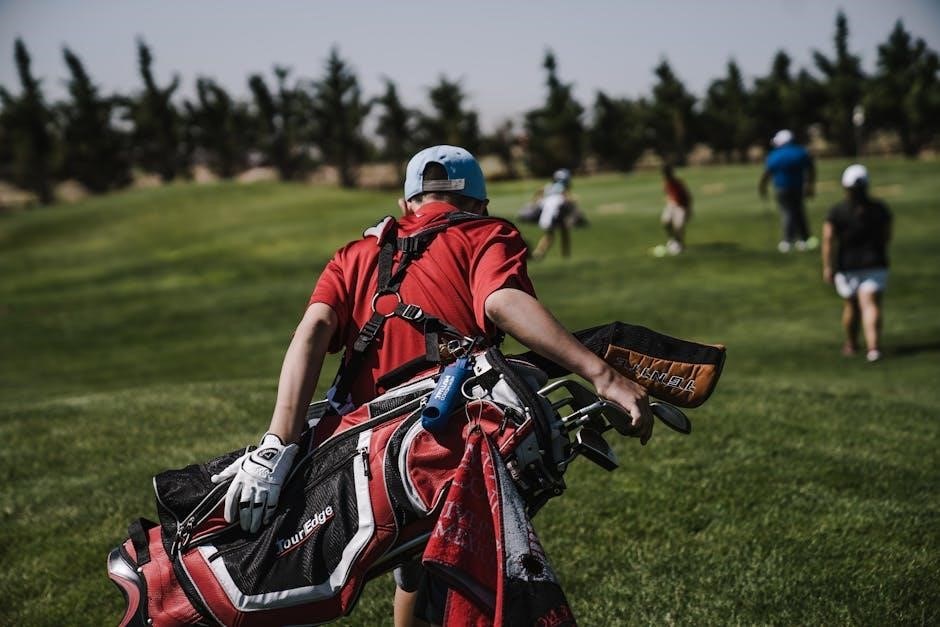
Factors Influencing Club Size
Height, swing speed, and tempo are key factors in determining the right club size for junior golfers. Proper sizing ensures optimal performance and technique development, promoting consistency and confidence in their game.
Height as the Primary Factor in Club Sizing
Height is the most critical factor in determining the appropriate size of junior golf clubs. Clubs that are too long or too short can hinder a young golfer’s ability to maintain proper posture and generate consistent swings. Junior clubs are designed to match the golfer’s height, ensuring the clubhead strikes the ball at the optimal angle. Properly sized clubs promote better technique, reduce fatigue, and enhance overall performance. Measuring a child’s height accurately and consulting a size chart or professional fitter ensures the best fit, allowing young golfers to develop their skills effectively. Height-based sizing is essential for long-term improvement and enjoyment of the game.
Other Factors: Swing Speed and Tempo
While height is the primary factor, swing speed and tempo also play a role in selecting junior golf clubs; A player with a faster swing speed may benefit from slightly heavier clubs or stiffer shafts, while slower swing speeds may require lighter clubs for better control. Tempo, or the rhythm of the swing, can influence how the club feels during the swing. Balancing these factors with proper height sizing ensures the clubs are tailored to the golfer’s unique needs, promoting consistency and confidence. Understanding swing speed and tempo helps fine-tune club selection for optimal performance and technique development in young golfers.
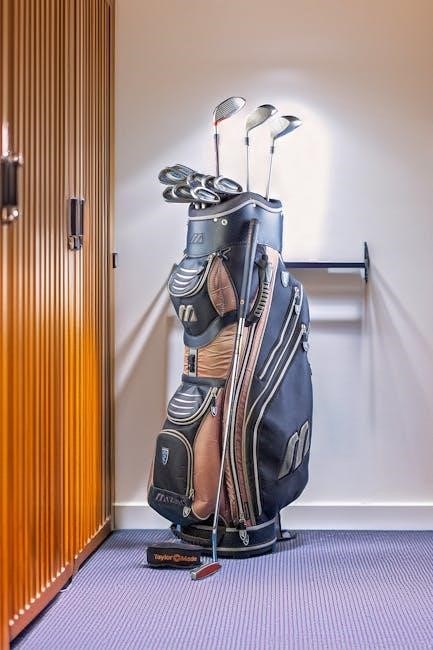
How to Measure for Junior Golf Clubs
Measuring your child’s height is essential for fitting junior clubs. Use a ruler or tape measure to ensure accurate club length and proper swing mechanics, helping determine the correct size.
Step-by-Step Guide to Measuring Your Child
To ensure proper fitting, measure your child’s height and wrist-to-floor length. Stand them upright, feet together, and measure from the floor to the top of their head. For wrist-to-floor, have them extend their arms at their sides; measure from the floor to their wrist crease. Use these measurements to determine club length using standardized charts. Ensure accuracy to avoid clubs that are too long or short, which can hinder swing mechanics and performance. Regular measurements are crucial as your child grows, allowing for adjustments and optimal fit. Proper sizing supports better technique and enjoyment of the game.
Understanding the Role of Wrist-to-Floor Measurement
Wrist-to-floor measurement is a critical factor in determining proper club length for junior golfers. This measurement, taken from the floor to the crease of the wrist with arms hanging straight, helps identify the ideal club length. It accounts for arm length relative to height, ensuring clubs are proportionate to the child’s body. Accurate wrist-to-floor measurements prevent clubs from being too long or short, which can affect posture, swing mechanics, and performance. Regular remeasurements are essential as the child grows, ensuring clubs remain appropriately sized. This measurement, combined with height, provides a precise fit for optimal swing consistency and comfort.
Age vs. Height in Club Selection
While clubs are often sold by age ranges, height is a more accurate determinant of proper fit, as it accounts for individual growth differences and swing mechanics.
Why Height is More Important Than Age
Height is a more reliable indicator of proper club fit than age, as it directly impacts the length and weight of clubs needed for optimal performance. While clubs are often sold by age ranges, this method can be less accurate due to varying growth rates among children. A taller junior may require longer clubs, while a shorter child needs shorter ones to maintain proper swing mechanics. Failing to consider height can lead to poor technique and reduced performance. By prioritizing height, you ensure the clubs are proportionate to the child’s body, promoting a consistent and effective swing. This approach avoids unnecessary adjustments and supports long-term development.
Common Mistakes in Choosing Clubs by Age
Choosing clubs solely based on age is a frequent error, as it ignores individual growth rates and swing styles. Many manufacturers market clubs by age ranges, but this approach often leads to improper fit. Clubs that are too long or short can hinder technique and performance. Additionally, assuming all juniors of the same age have similar swing speeds or body types is incorrect. This method overlooks the unique needs of each golfer, potentially leading to discomfort and inefficiency; Instead, focusing on height and swing mechanics ensures a more tailored fit, promoting better performance and enjoyment for young golfers.
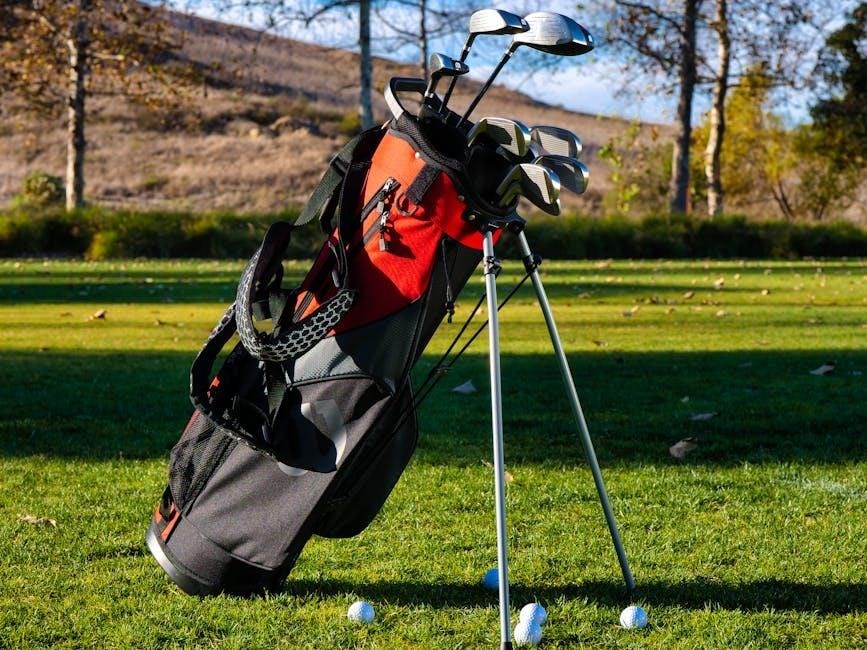
Junior Golf Club Size Charts
Junior golf club size charts categorize clubs by height, ensuring proper fit. Each size corresponds to a specific height range, helping young golfers maintain optimal swing mechanics and playability.
Standard Size Ranges for Junior Clubs
Junior golf clubs are designed in standard size ranges to accommodate growth stages. These ranges typically start with smaller clubs for younger children and progress to larger sizes as they grow. The clubs are categorized by height, ensuring proper fit and optimal performance. Each size range offers clubs with appropriate lengths and weights, allowing young golfers to maintain consistent swing mechanics. By aligning club size with the child’s height, juniors can develop their skills effectively and transition smoothly to larger clubs as they mature.
How to Interpret Club Length Charts
Club length charts are designed to help determine the appropriate club size based on a child’s height. Locate your child’s height on the chart’s Y-axis, then follow the corresponding row to find the recommended club lengths. Each club in the set, from the driver to the putter, will have a specific length tailored to the child’s stature. These charts ensure clubs are proportionate, allowing for proper swing mechanics. By aligning club length with height, young golfers can maintain consistency and control. Regularly updating clubs as your child grows ensures they never outgrow their equipment, promoting continuous improvement in their game.
Choosing the Right Club Length
Choosing the right club length ensures proper swing mechanics and consistent performance. Clubs should be proportional to the child’s height, allowing for adjustments as they grow.
Determining the Correct Club Length for Your Child
Determining the correct club length involves measuring your child’s height and swing mechanics. Use a size chart to match their height to the appropriate club length, ensuring proper posture and balance. This helps prevent injuries and improves performance. Regular check-ups are essential as children grow, typically every 6-12 months. Professional fittings can also provide personalized recommendations, ensuring clubs are tailored to their needs. Properly fitted clubs enhance technique and confidence, making the game more enjoyable for young golfers. Adjustments should be made gradually to maintain consistency in their swing development over time.
The Pros and Cons of Oversized Clubs
Oversized clubs can be beneficial for young golfers, as they often feature larger sweet spots, making it easier to hit consistent shots. This can boost confidence and improve performance. However, oversized clubs may be too heavy or long for smaller children, potentially hindering proper swing mechanics. Additionally, while they offer forgiveness, they might not promote precise control or technique development. Parents should weigh these factors, considering their child’s strength, height, and skill level. Oversized clubs can be a useful intermediate step but may require adjustments as the golfer grows or improves their game.

The Role of Club Fitting
Club fitting ensures clubs are tailored to a golfer’s size, strength, and swing, optimizing performance and technique. Proper fitting helps young golfers develop consistent swings and avoid injuries.
What is Club Fitting and Why is it Important?
Club fitting is a process where clubs are tailored to match a golfer’s unique swing characteristics, ensuring optimal performance and comfort. For juniors, it’s crucial as improper club length and weight can hinder technique development and lead to injuries. Professionals use tools like launch monitors and swing analyzers to determine the best club specifications. This personalized approach helps young golfers achieve consistent swings and build confidence, making it an essential step in their golfing journey. Regular fittings as they grow ensure they always have equipment that supports their progress.
Static vs. Dynamic Club Fitting
Static club fitting focuses on measuring a golfer’s posture and swing stance at address, using height and wrist-to-floor measurements to determine club length. Dynamic fitting, however, analyzes the golfer’s actual swing, considering factors like tempo, speed, and ball flight. For juniors, dynamic fitting is often more effective as it accounts for their natural swing characteristics, which may vary from the static position. This approach ensures clubs are tailored to their unique movement, enhancing performance and consistency. Combining both methods provides a comprehensive fit, but dynamic fitting is particularly beneficial for young golfers with developing swings.
Key Components of Junior Clubs
Junior clubs are designed with lightweight materials and appropriate loft angles to enhance swing mechanics and ball flight, ensuring proper weight distribution for developing golfers.
Weight Distribution in Junior Clubs
Weight distribution in junior clubs is crucial for ensuring proper swing mechanics and control. Clubs designed for young golfers are typically lighter to accommodate smaller frames and developing strength. Lightweight materials, such as graphite shafts, help reduce overall weight while maintaining balance. Proper weight distribution prevents fatigue and allows juniors to maintain consistent swing tempo. Manufacturers often design clubs with a higher moment of inertia (MOI) to enhance forgiveness without adding unnecessary weight. This balance ensures juniors can generate power and accuracy comfortably, fostering proper technique and enjoyment of the game. Correct weight distribution is essential for optimal performance and long-term skill development.
Loft Angles and Their Impact on Performance
Loft angles play a critical role in determining ball flight and distance for junior golfers. Clubs with appropriate loft angles ensure the ball reaches optimal trajectory, maximizing distance and accuracy; For young players, higher loft angles in drivers and fairway woods can help achieve better ball flight, while lower lofts in irons promote control. Proper loft angles also enhance forgiveness, reducing the impact of mishits. Manufacturers design junior clubs with age- and size-specific lofts to match developing swing speeds and strength levels. Correct loft angles are essential for consistent performance, enabling juniors to build confidence and improve their overall game effectively.
Transitioning as Your Child Grows
As children grow, their clubs must be adjusted to maintain proper fit and swing mechanics. Regularly monitor growth spurts and update equipment to ensure clubs remain proportional to their height, preventing technical issues and promoting consistent performance.
When to Upgrade to a Larger Set
Upgrading to a larger set becomes necessary when your child outgrows their current clubs, typically every 2-3 years. Look for signs such as clubs being too short, causing the child to stoop or lose balance during swings. Height is a key indicator; if your child exceeds the height range for their clubs, it’s time to consider a larger set. Additionally, improvements in swing speed or strength may warrant an upgrade to maintain proper technique and performance. Regularly assess their growth and skill level to ensure clubs remain appropriately sized.
Tips for a Smooth Transition to Adult Clubs
A smooth transition to adult clubs involves gradual adjustments. Start with a professional club fitting to ensure proper sizing and swing alignment. Introduce adult clubs incrementally, allowing your child to adapt to the heavier weight and longer length. Focus on maintaining consistent swing mechanics and posture. Consider a transition set with intermediate specs to ease the adjustment. Monitor progress and seek coaching to address any technique changes. Patience is key, as adapting to adult clubs can take time. This approach ensures your child’s game remains consistent and continues to grow effectively.
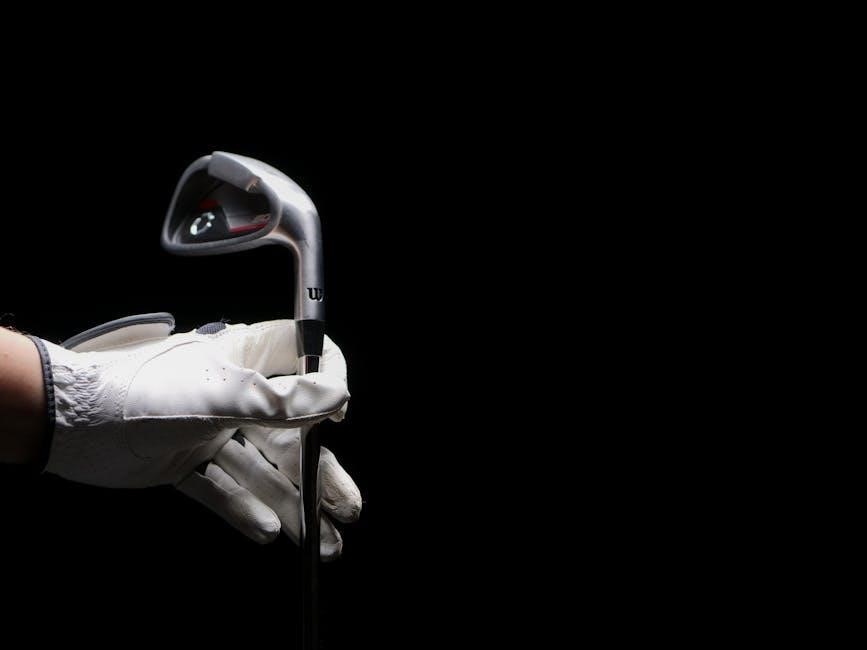
Budget Considerations
Balancing quality and cost is key when selecting junior golf clubs. Consider second-hand or last-season models for affordability without compromising performance. Proper sizing and fit are more critical than brand prestige.
Affordable Options for Junior Golf Clubs
Junior golf clubs don’t have to break the bank. Consider second-hand or demo clubs, which offer excellent value while maintaining quality. Online marketplaces and local golf shops often carry pre-owned sets tailored for young players. Additionally, many brands offer junior golf sets designed to grow with your child, reducing the need for frequent upgrades. Some manufacturers provide starter sets at lower price points without compromising on essential features. Investing in clubs that fit properly ensures your child can develop their skills effectively, making affordability and performance a winning combination for families.
Investing in Quality vs. Cost-Effective Sets
Deciding between quality and cost-effective junior golf clubs depends on your child’s skill level and commitment to the sport. High-quality clubs offer superior performance, durability, and customization options, ensuring proper fit as your child grows. They are a worthwhile investment for dedicated young golfers. However, cost-effective sets provide excellent value for casual play or younger players still developing their fundamentals. Many affordable options are designed to grow with your child, offering adjustable lengths and versatile features. Balancing budget and performance is key, ensuring your child enjoys the game while learning proper techniques.
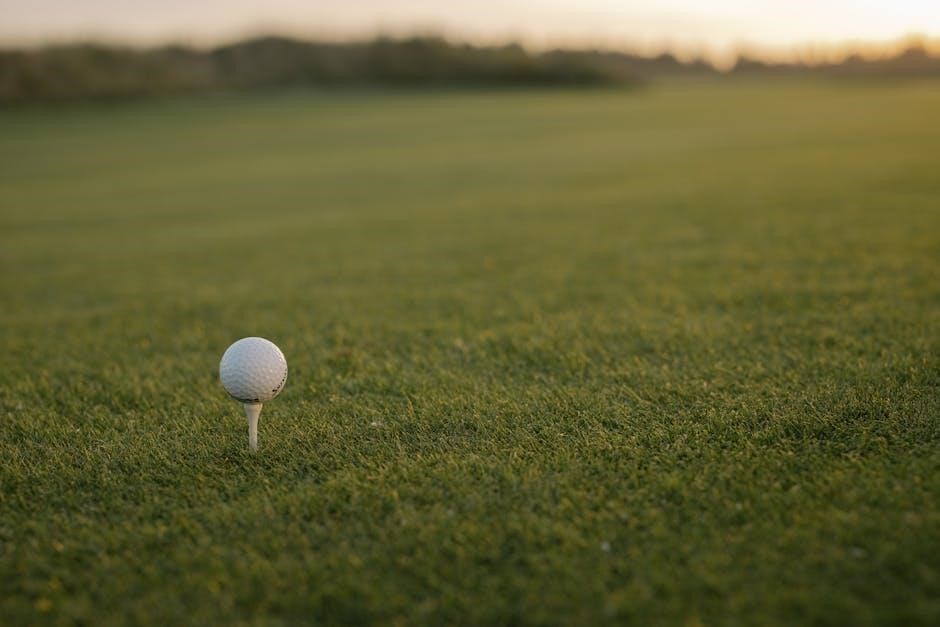
Popular Brands for Junior Clubs
Top brands like U.S. Kids Golf, Ping, and Callaway offer high-quality junior clubs designed for performance and growth. These brands provide adjustable, kid-friendly sets tailored to young golfers’ needs.
Top Manufacturers and Their Features
Leading brands like U.S. Kids Golf, Ping, and Callaway dominate the junior club market. U.S; Kids Golf is renowned for its height-based fitting system and lightweight designs. Ping offers customizable clubs with adjustable lies and shaft lengths, catering to growing golfers. Callaway provides junior sets with forgiveness and distance, featuring age-specific lofts. These brands prioritize performance, durability, and adaptability, ensuring clubs grow with the child. Their innovative technologies and focus on proper sizing make them top choices for young golfers seeking to improve their game. Each brand offers unique features tailored to enhance a junior golfer’s swing and overall performance.
What to Look for in a Junior Golf Set
When selecting a junior golf set, prioritize proper sizing based on the child’s height and swing mechanics. Opt for lightweight clubs with age-appropriate shaft lengths and flex to enhance swing speed and control. Adjustable clubs are beneficial as they grow. Look for sets with forgiveness and larger sweet spots to boost confidence. Consider the number of clubs, ensuring it meets the child’s skill level. Durability is key for long-term use. Custom fitting services can provide the best fit. Ensure the set aligns with the child’s growth, offering adaptability and performance as they develop their skills. Quality and fit are paramount for optimal results.
Properly fitting clubs are crucial for young golfers. Ensure they match the child’s height and swing mechanics for optimal performance and future growth. This fosters confidence and enjoyment.
Final Tips for Choosing the Right Clubs
Always prioritize proper club fitting to ensure optimal performance and technique development. Height is a more reliable indicator than age when selecting clubs. Consider adjustable clubs to accommodate growth. Ensure the club length allows your child to maintain a consistent swing. Avoid oversize clubs, as they can hinder proper mechanics. Swing speed and tempo should also influence club weight and flex. Invest in quality clubs that balance durability and cost. Regularly assess your child’s needs as they grow. Follow size charts but tailor choices to individual swing characteristics. Ultimately, focus on fostering confidence and enjoyment for long-term success in golf.